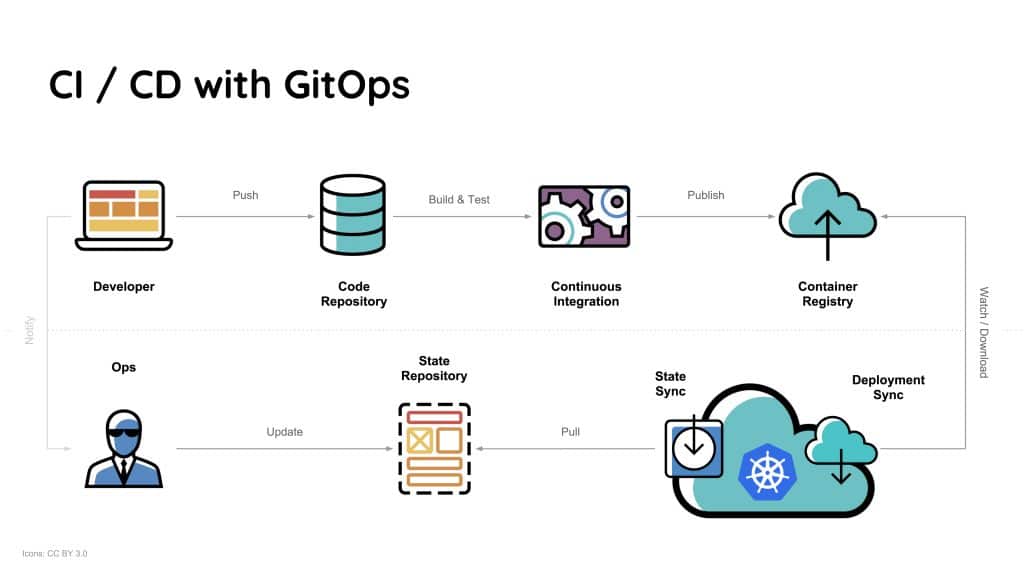Top 9 Vendor Risk Management Software for Infosec Pros in 2023
No single organization can master all trades, which is why their success hinges heavily on their vendors. And if vendors are crucial for your business operations,
DevOps has been the methodology of choice among developers for over a decade. No doubt, it’s proven its efficiency and ability to speed up processes while uniting teams by promoting open communication and shared responsibility. But will GitOps steal the spotlight? We’re exploring the answer in today’s post by looking at these two methodologies’ similarities and differences, advantages, and limitations.
GitOps is an operational framework that allows users to utilize Git, an open-source control system, to manage their infrastructure and application configurations. GitOps ensures that Git is the only source used for infrastructure and application management, giving it its name: GitOps stands for Git (the version control system) + operations (the resource management aspect of software development).

Additionally, the model uses Git to manage infrastructure provisioning and deployment automatically. The Git repository retains the entire state of the system, maintaining a clear record of changes made to the system. Like DevOps, GitOps is a framework designed to assist developers and teams in performing management activities while using existing software development processes, tools, and techniques.
Once upon a time, system administration used to be a manual task that required administrators to perform maintenance by connecting to machines in a physical server rack or over a cloud provisioning API. Manual configuration work was a routine occurrence and required administrators to keep extensive collections of imperative scripts and configurations which could easily get lost or broken.
The DevOps movement came up between 2007 and 2008 to address what IT operations and software deployment communities felt was dysfunctional in the industry – and streamlining this complex administrative system was undoubtedly up there in their list of priorities.

By borrowing some of the most efficient practices from software engineering and applying them to systems administration, DevOps allows the old patchwork collection of tools to be replaced by cohesive, version-controlled code. DevOps has successfully solved many of the problems with traditional systems administration by centralizing the storage of tools and configuration files and ensuring that they are accessible to a range of team members.
But even with DevOps, the configuration remains disconnected from the live system, which still needs to be manually updated to accurately reflect the static repository’s state. GitOps was developed as a solution to this problem: GitOps ensures that a system’s cloud infrastructure is immediately reproducible based on the state of a Git repository. The term GitOps was first coined in 2017 by WeaveWorks, an enterprise Kubernetes firm, and has since become a buzzword in the DevOps community.
The most notable difference between DevOps and GitOps is that DevOps is essentially a philosophy around how a team should function to succeed regardless of what tools they use, while GitOps relies on a particular tool, Git, as a source control system.
Furthermore, GitOps is goal-oriented. It leverages Git to pull requests to verify and automatically deploy system infrastructure modifications, with the aim to drive the organization closer to its goal. DevOps instead relies more on supplying best practices that can be generally applied to every process within an organization.
Another difference is that GitOps takes a declarative approach to operations, while DevOps embraces both declarative and prescriptive approaches, allowing its framework to fit monolithic application models and applications with limited componentization. That’s why DevOps can just as easily apply to VM and bare metal deployment as it does to containers.

DevOps centers itself on operations and, from the outset, is focused on deployment, which aligns well with enterprises that make slow application changes while facing daily configuration changes and hardware issues. In other words, DevOps is well suited for solving struggles around infrastructure changes such as migration to the cloud. Although well suited for software development and supporting application deployment, DevOps can also be helpful in monitoring, configuring, and managing infrastructure as code.
However, GitOps is quickly becoming a popular workflow for managing modern cloud infrastructure, particularly among organizations already committed to containerized applications, because GitOps helps to optimize CI/CD on Kubernetes. It redefines CI/CD, with Git (usually HitHub or GitLab) serving as the central, immutable state declaration for faster deployments.
GitOps easily integrates with DevOps, and because Git is a standard tool used among software developers, most devs are familiar with it, allowing them to participate in the various processes across the organization that utilize it.
The framework allows any changes made to your organization’s software to easily be tracked and monitored, making it easier to locate the source of any issues, comply with security regulations, and create a culture of transparency around organizational infrastructure.
GitOps can also increase team productivity, allowing developers to experiment with new configurations freely, as the Git history function allows teams to revert changes that don’t improve the system. This tool is handy as it allows developers to employ the familiar and straightforward “undo” function in new and complex infrastructure.
GitOps streamlines operational and maintenance processes. To illustrate, let’s use an example:
A team that encounters a problem such as a bottleneck or unplanned traffic spikes can turn to GitOps, review the infrastructure configuration, and search for the file containing the load balancer to ensure it’s operating correctly. The team can then adjust the configuration values of the load balancer as needed. Once the team creates a pull request to optimize the load balancer values, the request is reviewed. Once it is confirmed, the GitOps orchestrator system automatically updates the live system.
In a scenario where the team prefers to deploy an entirely new load balancer rather than tweak the original values, the system will again update to reflect the new situation. If the new load balancer is incompatible and creates issues, the team can quickly identify the source of trouble and easily revert the system to its original load balancer.

With the advent of GitOps, it may seem like DevOps is on its way to becoming obsolete, but that couldn’t be further from the truth. GitOps acts as a complement to preexisting DevOps strategies, making experimentation more straightforward and automating infrastructure deployment.
While integrating the systems is simple due to their similar toolsets, the methods are not codependent, and despite their similar principles, one doesn’t necessitate the other. Teams without DevOps can still utilize GitOps, and teams with DevOps methodology in place don’t have to.
DevOps and GitOps may focus on different stages in the software development lifecycle, but throughout both, maintaining a high level of cyber security is equally important. Integrating security into all software lifecycle stages ensures your system remains secure and protected. So start your development journey securely today with Spectral.

No single organization can master all trades, which is why their success hinges heavily on their vendors. And if vendors are crucial for your business operations,

Integration is an indispensable aspect of modern software development. As software applications become more complex and interconnected, every component must work seamlessly together like a game

Modern companies are rapidly adopting cloud applications and services due to scalability, cost savings, and faster time to market. DevOps teams and developers must deliver fast,